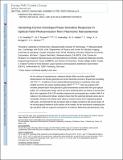Vanishing carrier-envelope-phase-sensitive response in optical-field photoemission from plasmonic nanoantennas
Author(s)
Keathley, PD; Putnam, WP; Vasireddy, P; Hobbs, RG; Yang, Y; Berggren, KK; Kärtner, FX; ... Show more Show less
DownloadAccepted version (1.059Mb)
Publisher Policy
Publisher Policy
Article is made available in accordance with the publisher's policy and may be subject to US copyright law. Please refer to the publisher's site for terms of use.
Terms of use
Metadata
Show full item recordAbstract
© 2019, The Author(s), under exclusive licence to Springer Nature Limited. At the surfaces of nanostructures, enhanced electric fields can drive optical-field photoemission and thereby generate and control electrical currents at frequencies exceeding 100 THz (refs. 1–11). A hallmark of such optical-field photoemission is the sensitivity of the total emitted current to the carrier-envelope phase (CEP)1–3,7,11–17. Here, we examine CEP-sensitive photoemission from plasmonic gold nanoantennas excited with few-cycle optical pulses. At a critical pulse energy, which we call a vanishing point, we observe a pronounced dip in the magnitude of the CEP-sensitive photocurrent accompanied by a sudden shift of π radians in the photocurrent phase. Analysis shows that this vanishing behaviour arises due to competition between sub-optical-cycle electron emission events from neighbouring optical half-cycles and that both the dip and phase shift are highly sensitive to the precise shape of the driving optical waveform at the surface of the emitter. As the mechanisms underlying the dip and phase shift are a general consequence of nonlinear, field-driven photoemission, they may be used to probe sub-optical-cycle emission processes from solid-state emitters, atoms and molecules. Improved understanding of these CEP-sensitive photocurrent features will be critical to the development of optical-field-driven photocathodes for time-domain metrology and microscopy applications demanding attosecond temporal and nanometre spatial resolution.
Date issued
2019Department
Massachusetts Institute of Technology. Research Laboratory of ElectronicsJournal
Nature Physics
Publisher
Springer Science and Business Media LLC